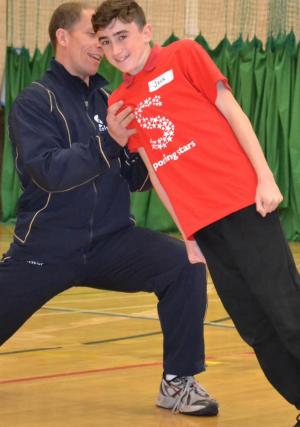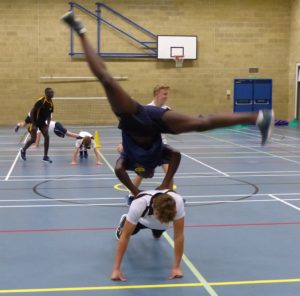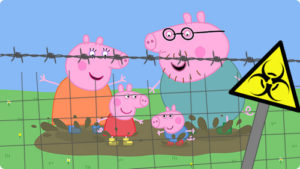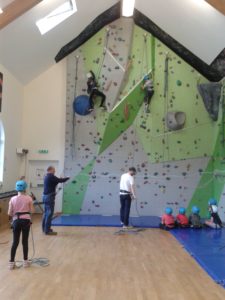What is physical literacy?

Bracing, posture and balance
What is Physical Literacy?
Physical Literacy is a term gaining currency to help promote the need for children to be given the opportunities to move. Physical education has been squeezed out of the school curriculum, competitive sports have taken over and many children are disheartened and therefore disengaged.
“Partly through lack of sufficient activity, some children are awkwardly overgrown while others are fat and flabby so that eventually the desire for movement is lost and they join the ranks of the physically illiterate.”
Ruth Morison (1969) 1.
A physically literate individual “moves with poise, economy and confidence in a wide variety of physically challenging situations” (2).
“Physically challenging” situations could include sporting activity such as tennis, family games such as Twister, or being able to play tag in the playground or copying dance moves from Ciara!
By being physically literate, the child, and then the adult, will have a much better chance of finding something they can do and like and take part in.”If you teach them to move well, you don’t have to tell them to move often.” Rita Parish (3).
Literacy and numeracy are cornerstones of education in the UK and around the world. Children are educated, tested and retested continuously. There are league tables that compare class to class and school to school. There is a relentless pursuit to “improve standards”.
Unfortunately, the same amount of effort is lacking when it comes to physical literacy.
Moving is Learning
Nearly 50 years ago Morison wrote that “the increasing supply of ready-made entertainment and mechanical means of transport compel many children to quell their natural urge to move, and their inactivity makes them dull and passive.”
This was before iPads, smartphones and when most families were lucky to have one car.
“Learning is the process whereby knowledge is created through the transformation of experience.” (4).
If children watch tv before school, are driven to school, sit in an assembly for 45 minutes, kept inside at break time, miss p.e. because the hall is in use for the nativity play, driven home, watch tv, go to bed how do they learn to move?
- A worrying statistic is that in 1985 the average child played outside for 30 hours per week, in 2005 this was down to 5 hours per week (5).
- That means the average 15 year old in 2018 will have 12,250 fewer hours of accumulated free playtime compared to their 1985 counterpart.
For the “sporty” kids today, this means they are in danger of over specialisation and overuse injuries. For the “non-sporty” kids this means they are lacking in basic movement skills and feel inhibited and lack the confidence to try.
Children teach themselves physical literacy
Given the opportunity, children want to move and explore. In an over mechanised society, the last thing children need is to be put on a machine to exercise. The dull repetitive nature of treadmills, adductor leg machines and cross trainers replace the joy of movement and discovery with mind-numbingly boring labour.
There is more to physical literacy than improving simple physiological functions: sitting on an exercise bike will improve your heart and lung function, but it will do nothing for balance, coordination or skill (pretty hard to pull a wheelie on one too).
“The richer the interactions, the more individuals develop their human potential“. Margaret Whitehead (2001). (2).
Without these rich interactions, our children will never reach their full potential. Driving your child to a swimming lesson and watch someone else give them instructions for 20 minutes out of 30 minutes is far from being rich or interacting.
Instead, these might surprise you as examples:
- Jumping in muddy puddles (kids have to be outside and in the wet, and on uneven ground).
- Splashing in the bath.
- Going down a slide (and climbing up the ladder to get there).
- Hanging upside down holding onto parent’s hands.
- Wrestling with siblings.
- Crawling around the house (not left in a cot or in a car seat during “play dates”.
- Walking to school (or skipping, hopping, running, tripping, scootering, cycling, skateboarding).
- Playing in the pool with family (emphasis on playing, children need to be comfortable in a strange environment before even beginning to listen to an instruction).
- Hopscotch, skipping, jacks, bean bag throws, frisbee, paper aeroplanes, stone skimming and jumping over puddles are all “rich interactions” which should be numerous before even going to an athletics club.
- Throwing paper (like in the video below) is fun and will help develop the child’s underlying skills.
Apart from going to the swimming pool, all the above are free and therefore should be familiar to all children. However, they require time which is precious and they may seem trivial to adults (who are often looking for the next big thing to post on Facebook).
Summary
The major point being that this unstructured, messy, disorganised PLAY, allows children to make mistakes and adapt to the environment around them. This then gives them a large database of experiences that they can draw upon when needed in the future.
Watching my children’s 73-year-old Gran learn Bollywood style dancing last week for the first time in a workshop was a delight. Her physical literacy gained as a child in the 1950s enabled her to participate and thrive in a new environment.
Will your kids be able to do the same in 60 years time?
Want to learn more?
- We are run one-day workshops on Educational Gymnastics and Athletic Development that will give you a framework and practical ideas to help you help children learn to move better.
- Read “Physical Literacy and Athletic Development” review of the seminar by Vern Gambetta.
- Join our Athletic Development club
References
- A Movement Approach to Educational Gymnastics: Ruth Morison (1969).
- Margaret Whitehead (2001) The Concept of Physical Literacy, European Journal of Physical Education, 6:2, 127-138.
- Personal communication with Rita Parish, Willand Tennis Club 2013.
- Experiential Learning: David Kolb (1984).
- Personal communication Honore Hoedt Scottish Athletics Conference 2016.




[…] expanded the Physical Literacy analogy by putting this sequence […]